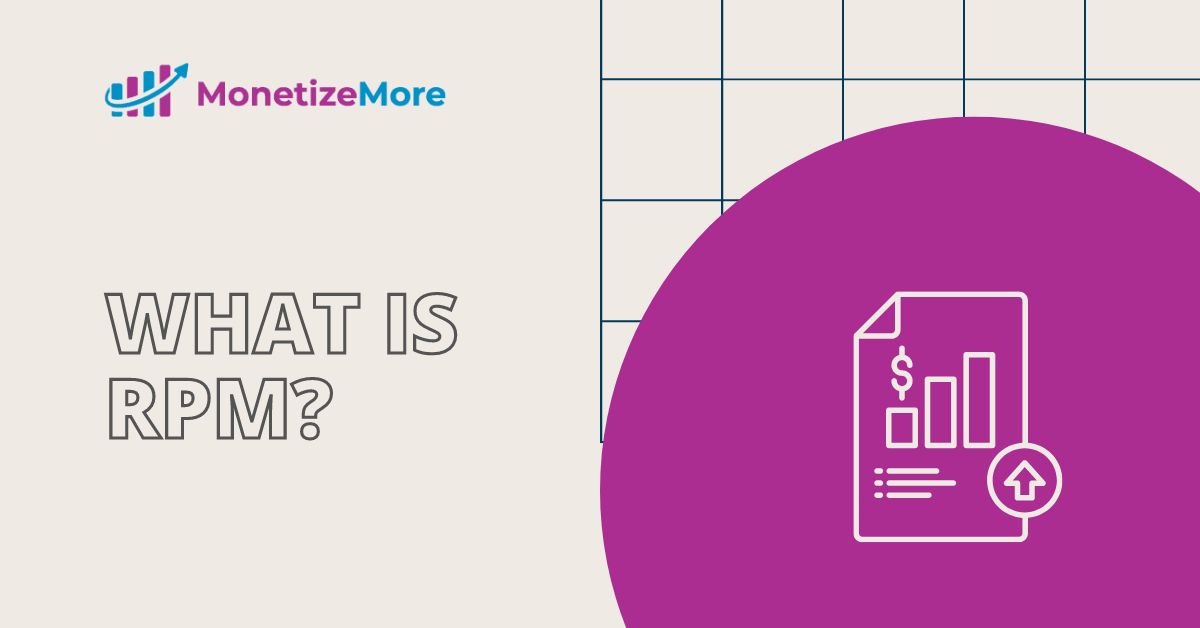
This post was most recently updated on February 21st, 2024
There are several key metrics that publishers and advertisers use to measure performance and optimize their strategies. One such metric is RPM, or revenue per thousand impressions. RPM measures how much revenue a publisher generates for every thousand ad impressions served on their website or app. It’s an important metric because it can help publishers understand the effectiveness of their ad inventory and make informed decisions about ad placement, format, and targeting.
RPM allows publishers to track and optimize revenue, which is the lifeblood of their business. By understanding how much revenue they’re generating for each ad impression, publishers can make informed decisions about which ads to serve and where to place them, ultimately maximizing revenue and delivering a better user experience for their audience. Additionally, advertisers can use RPM data to evaluate the effectiveness of their campaigns and make adjustments to improve performance.
By understanding how RPM works and how it can be optimized, businesses can drive more revenue, improve user experience, and ultimately achieve their advertising goals.
Also, find out more about the difference between page views and impressions here:
https://www.monetizemore.com/blog/google-analytics-pageview-vs-ad-manager-impressions/
RPM is a common metric that most advertising platforms such as ad networks and ad servers use. It represents the cost the advertiser will pay for every 1,000 ad impressions served on a publisher’s website.
To calculate the RPM, we need to divide the Revenue by Ad Impressions and multiply it by 1,000 using the formula below.
RPM = ( Revenue / Impressions ) x 1,000
Let’s say we want to calculate the RPM for Oct 18, 2018. The site earned an estimated $133.04 for 104,752 ad impressions.
RPM = ( 133.04 ÷ 104,752 ) x 1,000
RPM = $1.27
This indicates that for every 1,000 ad impressions served on a publisher’s website they earn $1.27.
From a publisher’s point of view, this is a good metric to look at, but not the best to define a site’s performance. There’s a big possibility that even if the RPM increases, the overall site revenue could be inversely proportional to it.
However, since RPM is the total amount of all CPMs on a specific page, it’s a good performance indicator for different ad types on a page.
The page RPM metric helps publishers understand the performance of their ads on a page level. This way, you can identify low-earning pages and strategize how to improve their performance.
Page RPM is the rate the advertiser pays for every 1,000 ad impressions viewed per page. You can calculate RPM by dividing your estimated earnings by the number of page views and then multiply it by 1,000.
Page RPM = ( Revenue / Number of page views) x 1,000
To better understand it, let’s calculate the page RPM for Oct 22, 2018.
Estimated earnings = CA$191.93
Page views = 419,470
Page RPM = ( 191.93 ÷ 419,470 ) x 1,000
Page RPM = CA$ 0.46
For every 1000 impressions this particular page of the publisher’s website received, they earned $0.46 in ad revenue.
Page RPM is an excellent comparative metric to evaluate multiple page performance on your website. It gives you an appreciation of what’s going on with your pages regarding revenue at any comparable period, page to page, etc.
Take note that an increase in page RPM results in an increase in the total revenue of the website.
Out of the three metrics we covered here, session RPM is the best metric to reference when analyzing overall site performance. This metric directly shows a site’s ad earnings per visitor. It also gives you a better understanding of which landing pages gain revenue the most.
To calculate session RPM, divide your earnings by visitor sessions and then multiply them by 1,000, corresponding to one thousand website visits.
Session RPM = ( Revenue / Number of ad sessions) x 1,000
Let’s say we want to calculate the Session RPM for Oct 20, 2018. 54,403 ad sessions generated $120.68 in estimated earnings.
Session RPM = ( 120.68 ÷ 54,403) x 1,000
Session RPM = $2.22
Follow these practices and never complain after that:
Each metric we covered here has its use in monitoring site performance. If you want to check the performance of different ad types on a page, then you may utilize the RPM metric.
If you want to evaluate your site performance at the page level, use page RPM. If you will assess your site’s overall performance, use the session RPM metric.
With all the metrics discussed, session RPM is the best parameter that allows publishers to gauge the overall performance of a site. This metric shows how well or how good a site’s ad earnings are per visitor.
If you want to take your ad earnings to the next level, why not let the experts help? MonetizeMore is a Google Certified Publisher Partner, and our team of ad optimization specialists is standing by, ready to assist you in maximizing your ad revenue. Sign up for a Starter account at MonetizeMore today!
Best ways to increase Page RPMs
CPM stands for cost per thousand impressions and is a metric used by advertisers to measure the cost of serving ads. RPM, on the other hand, measures the revenue generated by publishers for every thousand ad impressions served. In other words, CPM is a cost metric, while RPM is a revenue metric.
RPM can be calculated for any ad format by dividing the total revenue generated by the number of ad impressions served, then multiplying by 1000. For example, to calculate RPM for video ads, you would divide the total revenue generated by the number of video ad impressions served, then multiply by 1000.
In addition to ad placement and user engagement, other factors that can impact RPM include the quality of the ad inventory, the demographics and behavior of the target audience, the type of ad format and creative used, and the overall demand for ad space.
In addition to optimizing ad placement and format, publishers can increase their RPM by focusing on audience targeting, implementing header bidding, using data and analytics to understand their audience, and experimenting with different pricing strategies. Additionally, publishers should regularly monitor their ad performance and make adjustments to optimize their RPM over time.

With over ten years at the forefront of programmatic advertising, Aleesha Jacob is a renowned Ad-Tech expert, blending innovative strategies with cutting-edge technology. Her insights have reshaped programmatic advertising, leading to groundbreaking campaigns and 10X ROI increases for publishers and global brands. She believes in setting new standards in dynamic ad targeting and optimization.



10X your ad revenue with our award-winning solutions.